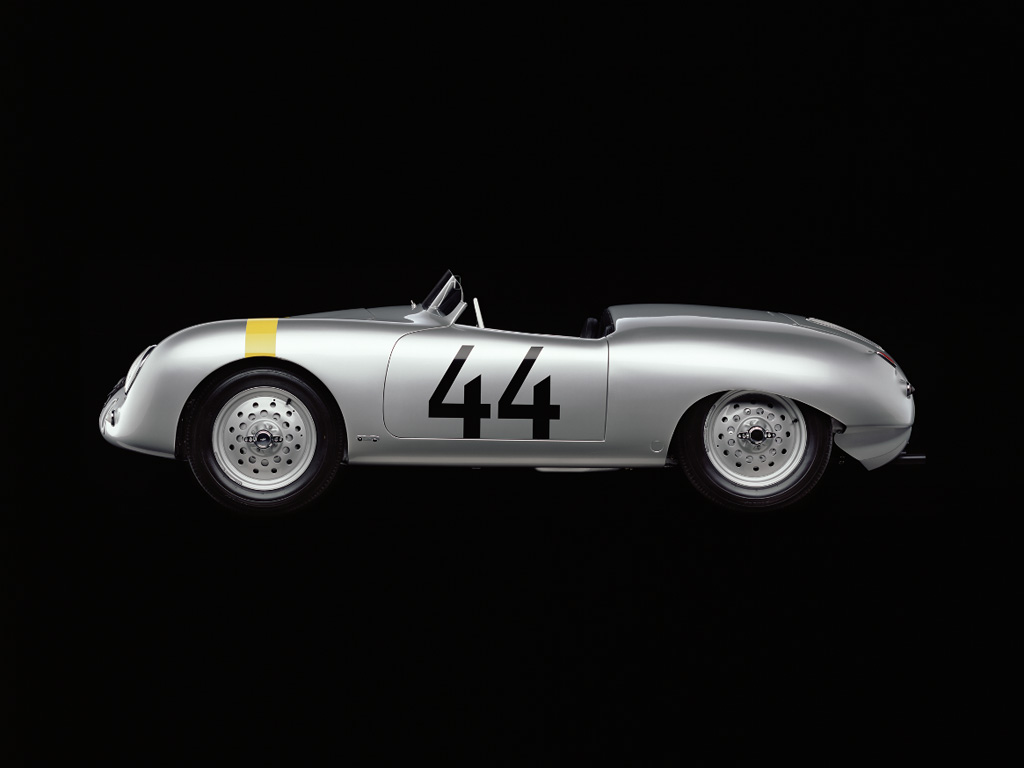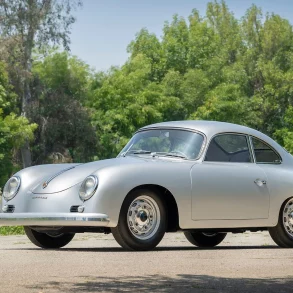1952 Porsche-Glöckler 356 Roadster – Ultimate Guide
Successful VW Dealer and racer Walter Glöckler built several specials for the German Car Championship including this roadster. It was built with assistance from Porsche in Zuffenhausen and raced without its optional hardtop in the 1952 champion before being shipped overseas for SCCA racing.
In 2005 the car was sold by Gooding & Company at their Palm Beach Auction and it was described as follows:
The third Glockler-Porsche adopted the standard Porsche rear-engined layout with the rear suspension in its ‘proper’ trailing-arm configuration. Based on a standard Porsche cabriolet floorpan, Ramelow undertook the now-standing lightening modifications, removing everything that was nonessential and drilling out much of what was left. A 1,488 cc Porsche engine, again tuned with high compression to run on alcohol, made 86 horsepower.
Weidenhausen created the body from aluminum with a nose that bore close resemblance to the 356 Porsche but had semi-skirted rear wheels and cutaway rear corners similar to Glockler-Porsche 1 and 2. The standard two-seat interior layout of the cabriolet with the driver on the left was retained although very lightweight bucket seats were fabricated and installed. Its standard Porsche floorpan and two-seat interior brought a weight consequence even with Ramelow’s extensive lightening efforts, and Glockler-Porsche Number 3 weighed some 1,133 lbs.
Like the earlier Glockler-Porsche, Number 3 had a full belly pan below the Porsche floorpan and had an air intake low on the nose for an oil cooler. Small air intakes on each side of the nose brought cool air to the front brakes. It was designed from the outset with a removable coupe roof with flush-fitting windshield, side windows and rear glass for minimal surface drag. The low windshield was integrated with the body. At various times both the AFM magnesium wheels and knockoff steel wheels were fitted; the steel wheels, like the rest of the Glockler-Porsche, were drilled for lightness and brake cooling.
Walter Glockler turned the driving over to his cousin, Helm, who won his class and set a new class record in the spring of 1952 race at the Nurburgring (running without the hardtop) on his way to winning the 1952 German championship. In August, Hans Stanek, of the Swiss VW/Porsche importer AMAG, hill-climbed it, then it was sold to Max Hoffman in the U.S., complete with the hardtop and AFM magnesium wheels.
Upon receiving it, Hoffman entered the May 1953 road races at Bridgehampton on Long Island but turned the driving over to Johnny Von Neuman, soon-to-be successful Porsche distributor on the West Coast. Von Neuman finished third in the 1,500 cc class and brought the Glockler-Porsche and Hoffman valuable publicity, including the cover photo in the September-October 1953 issue of the SCCA magazine, Sports Car. Shortly thereafter Hoffman sold Glockler-Porsche Number 3 to Fred Proctor, Jr. of Connecticut.
Porsche took his new Glockler-Porsche to the Giant’s Despair hill-climb and Brynfan Tyddyn road races in Pennsylvania in July 1953 and finished second in class in both events. Another second followed on August 8 at Lockbourne Air Ford Base in Ohio, then a third at Thompson Raceway in Connecticut.
After that, the Glockler-Porsche Number 3 disappeared for several years before showing up in 1958 in Denver in the hands of Alex Thompson. Its appeal and quality apparently endeared it to Denver-area enthusiasts, and it passed through several hands including Charlie Lyons’ and possibly even Bob Carnes’, the creator of the Bocar specials, before ending up with automotive sculptor Larry Braun of Loveland, Colo., in the late ’60s.
Braun began a restoration which languished semi-finished for many years stored in an open shed, but the car was fortunately preserved by the arid Colorado climate unit it was eventually located and acquired by the present owner in 2000. A comprehensive restoration was needed, and for this the Glockler-Porsche was sent to Tempero Restorations in New Zealand, specialists in restoring and constructing lightweight aluminum body work. The restoration has only recently been completed.
This historic and important Glockler-Porsche roadster is correctly marked with only Porsche identification, indicative of the close cooperation between Glockler and Porsche in the development of high-performance sports cars for competition. Its influence upon Porsche, and particularly on Max Hoffman’s insistence that Porsche develop the lightweight Speedster for the U.S. market, makes it one fo the most important of the Glockler-Porsches. It is brilliantly restored in Porsche Silver with black interior and carries a yellow nose band similar to its livery at Nurburging when it was raced by Helm Glocker in August 1952.
The workmanship is absolutely of the highest quality and includes careful restoration of the elaborate brass fuel tanks surrounding the spare-tire pocket in the nose, specially constructed and sealed to withstand the corrosive effects of its alcohol fuel. The removable hardtop has been meticulously re-created using a surviving portion of the fire-damaged original top as the pattern, along with the low windshield to which it mates for high-speed tracks. It rides on BMW 328-style disc wheels, but a pair of the original magnesium wheels have survived. It has been restored with the engine that was with the Glockler-Porsche in Colorado; however it is believed that the aluminum and magnesium in the original engine, as well as several that followed it, were corroded beyond repair by the alcohol fuel.
Specifications
| submitted by | Richard Owen |
| type | Racing Car |
| built at | Frankfurt, Germany |
| coachbuilder | Weidenhausen |
| engineers | Hermann Ramelow |
| production | 1 |
| engine | Air Cooled Flat-4 |
| displacement | 1488 cc / 90.80 in³ |
| power | 64.1 kw / 86 bhp |
| specific output | 57.8 bhp per litre |
| bhp/weight | 167.32 bhp per tonne |
| body / frame | Aluminum body over 356 Unitary Steel Monocoque |
| driven wheels | RWD |
| r suspension | Trailing Arms |
| curb weight | 514 kg / 1133 lbs |
| transmission | 4-Speed Manual |











